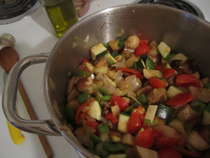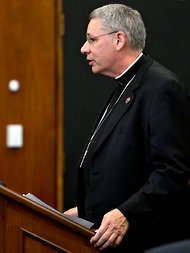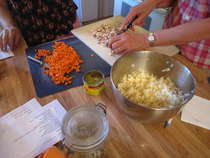 PHOTO: Mary van Balen In today’s gospel reading, it was the little things the woman noticed when Jesus entered Simon’s house: No one brought water to wash Jesus’ dusty feet; no one greeted him with a kiss; no one wiped his face and refreshed it with oil. Changed by his words of God’s loving forgiveness, she had come to seek him out. Perhaps to give thanks for lifting a burden from her heart and replacing it with hope.
PHOTO: Mary van Balen In today’s gospel reading, it was the little things the woman noticed when Jesus entered Simon’s house: No one brought water to wash Jesus’ dusty feet; no one greeted him with a kiss; no one wiped his face and refreshed it with oil. Changed by his words of God’s loving forgiveness, she had come to seek him out. Perhaps to give thanks for lifting a burden from her heart and replacing it with hope.
The lack of honor shown to this man moved her to tears, and she washed his feet with them, drying with her hair. She broke her alabaster jar of perfume and anointed his feet, covering them with kisses as she did.
Simon was shocked and offended. Jesus felt the warmth of her love and said so: She had been forgiven much and she loved much. He had no such words for his host, who, if he were open to the moment, was abashed.
A lifetime of paying attention to the “little things” make a saint. Liturgical Press’ September “Give Us This Day” book of prayer, a short reflection on the life of Daria Donnelly is offered as an example of one made holy by living ordinary life fully and with love. She was an editor of “Commonweal” magazine, a wife and mother. She died at forty-five of multiple myeloma. Her witness? In her words: “The only thing that matters is showing love and compassion in the time that is given us.”
Most of us live ordinary lives, work day in and day out at jobs that may or may not be fulfilling in themselves. We are parents and children; aunts and uncles; neighbors and strangers. But each day, each moment is an acceptable time for the inbreaking of grace and love. Present to the moment, we are surprised by beauty and kindness.
This morning, I woke with a “to do” list stamped in my brain. I washed dishes and, suspecting a nail in its tire, took my car to a local mechanic to check. He asked for an hour. I walked down the street to a small restaurant and treated myself to breakfast and time to write a bit in my journal. On the walk back, I noticed a leaf on the sidewalk. Or more accurately, the leaf called to me, bright with large dew drops throwing the morning sun out for passersby to see.
Stooping down for a closer look, I pondered the fall season, the large size of the drops, and the brilliance of the sun. Grace, inbreaking.
“Yep, it was a nail. Keys are in the car.”
“What do I owe you?”
“Nothing.” He smiled. Grace again.
A sweet sense of peace replaced nagging concern with my mental chores list. While I spend the rest of my day selling home-goods to bargain seekers, I will pass the peace along. Department store or office; strangers or friends; commerce or solitary work. All are acceptable times and places for God’s Grace to show up and continue the work of transformation.
 Rita Frye PHOTO: Mary van Balen “Well, Hello!” Rita’s voice came over my cell. I couldn’t believe we had connected, expecting instead to leave a message.
Rita Frye PHOTO: Mary van Balen “Well, Hello!” Rita’s voice came over my cell. I couldn’t believe we had connected, expecting instead to leave a message.
 PHOTO: Mary van Balen No, not a “lousy T-shirt.” While admitting to a bit of beach envy, I was happy to receive the bounty of my brother-in-law’s garden and produce from their refrigerator which would not last the week. Michael’s homegrown eggplant, peppers, tomatoes, and potatoes inspired me to create my own ratatouille this morning. I threw in some zucchini, onion, garlic, and fresh basil and thyme snipped in the rain from my potted herb garden.
PHOTO: Mary van Balen No, not a “lousy T-shirt.” While admitting to a bit of beach envy, I was happy to receive the bounty of my brother-in-law’s garden and produce from their refrigerator which would not last the week. Michael’s homegrown eggplant, peppers, tomatoes, and potatoes inspired me to create my own ratatouille this morning. I threw in some zucchini, onion, garlic, and fresh basil and thyme snipped in the rain from my potted herb garden.  Not only do I have lunch and dinner for a couple of days, I have an apartment filled with the earthy aromas of fresh vegetables and herbs. A perfect compliment to a grey, rainy morning.
Not only do I have lunch and dinner for a couple of days, I have an apartment filled with the earthy aromas of fresh vegetables and herbs. A perfect compliment to a grey, rainy morning.  News coverage of the riots and deaths stemming from rage at the short movie, “Innocence of Muslims” reminded me of a
News coverage of the riots and deaths stemming from rage at the short movie, “Innocence of Muslims” reminded me of a 

 The Catholic hierarchy is notoriously secretive. When they backslide again it will be hard to catch them, everyone involved must be hyper vigilant if kids are truly to be safe.
The Catholic hierarchy is notoriously secretive. When they backslide again it will be hard to catch them, everyone involved must be hyper vigilant if kids are truly to be safe.
 Sister Simone Campbell at the DNC On Wednesday, the Nuns on the Bus arrived at the Democratic National Convention and one of them, Sister Simone Campbell, stood on the podium to remind those with ears to hear that the Romney/Ryan budget “failed a moral test,” echoing the statement of the United States bishops.
Sister Simone Campbell at the DNC On Wednesday, the Nuns on the Bus arrived at the Democratic National Convention and one of them, Sister Simone Campbell, stood on the podium to remind those with ears to hear that the Romney/Ryan budget “failed a moral test,” echoing the statement of the United States bishops.  As election day approaches, people of faith, no matter the denomination, have much to consider, including the implications of adoption of the Republican budget that includes huge tax cuts for the wealthiest, repeal of the Affordable Care Act, and budget cuts in programs like food stamps.
As election day approaches, people of faith, no matter the denomination, have much to consider, including the implications of adoption of the Republican budget that includes huge tax cuts for the wealthiest, repeal of the Affordable Care Act, and budget cuts in programs like food stamps.
 from the film: “The Intouchables” (Originally published in the Catholic Times, August 26, 2012 © 2012 Mary van Balen)
from the film: “The Intouchables” (Originally published in the Catholic Times, August 26, 2012 © 2012 Mary van Balen) Then there was the Public Marketplace, as noisy and crowded as the garden was quiet and nearly empty. Booth after booth of fresh flowers were a riot of color and reminded me a bit of Thailand markets. Jewelry, clothing, artwork, fruits, vegetables, and yes, the fish market where crabs and whole salmon are tossed about. So NOT Ohio.
Then there was the Public Marketplace, as noisy and crowded as the garden was quiet and nearly empty. Booth after booth of fresh flowers were a riot of color and reminded me a bit of Thailand markets. Jewelry, clothing, artwork, fruits, vegetables, and yes, the fish market where crabs and whole salmon are tossed about. So NOT Ohio.

 I thought about these things as I drove to spend the morning with my sister-in-laws learning to cook a healthy, meatless meal. My sister and I had a great time and eventually brought home some delicious food for dinner. I mentioned Rose of Lima and my discoveries about her.
I thought about these things as I drove to spend the morning with my sister-in-laws learning to cook a healthy, meatless meal. My sister and I had a great time and eventually brought home some delicious food for dinner. I mentioned Rose of Lima and my discoveries about her.  Or maybe working two jobs to make ends meet. Or using the free time economic security provides to volunteer somewhere. It can mean eating less and more healthily (as my morning of cooking prodded me to consider), consuming less material goods. Just allowing oneself times of quiet and prayer can be challenging today.
Or maybe working two jobs to make ends meet. Or using the free time economic security provides to volunteer somewhere. It can mean eating less and more healthily (as my morning of cooking prodded me to consider), consuming less material goods. Just allowing oneself times of quiet and prayer can be challenging today.  “Gratia Plena” by Stephen Heilmer PHOTO: Mary van Balen
“Gratia Plena” by Stephen Heilmer PHOTO: Mary van Balen  Abbot John Klassen OSB PHOTO: Sr. Edith OSB Part Two: “I am doing something NEW….”
Abbot John Klassen OSB PHOTO: Sr. Edith OSB Part Two: “I am doing something NEW….”